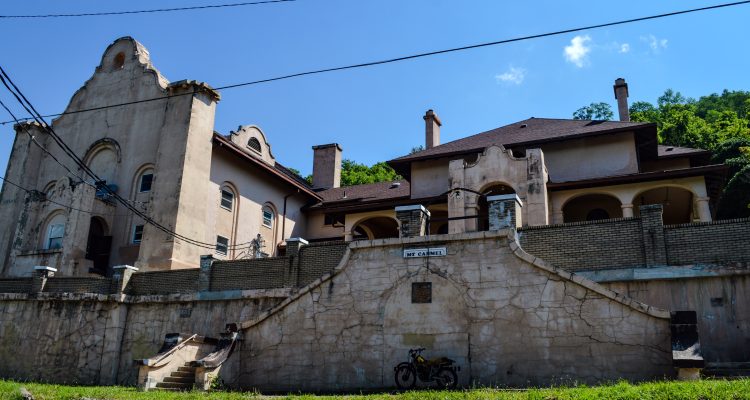They chose an existence behind towering walls, a spiked, steel grille, and solitary prayer and absolute poverty while living away from their friends and families never to be seen again by a member of society.
As members of the Order of the Discalced Carmelites these sisters turned away from the world to take up His Cross, a commitment of complete Faith, and one full of prayer for folks they would never, ever meet face to face. The Carmelite Order was the strictest of all female religious orders, and self-flagellation accompanied a mission of prayer while belonging solely to Jesus Christ.
The Carmelites, named after Mount Carmel in Palestine, first arrived to America in 1790, when they settled in Fort Tobacco near the city of Baltimore. In the early 1900s, Bishop Patrick Donahue of the Wheeling diocese requested the Carmelite sisters come to Wheeling, and four nuns from the Baltimore and Philadelphia areas arrived in 1913.
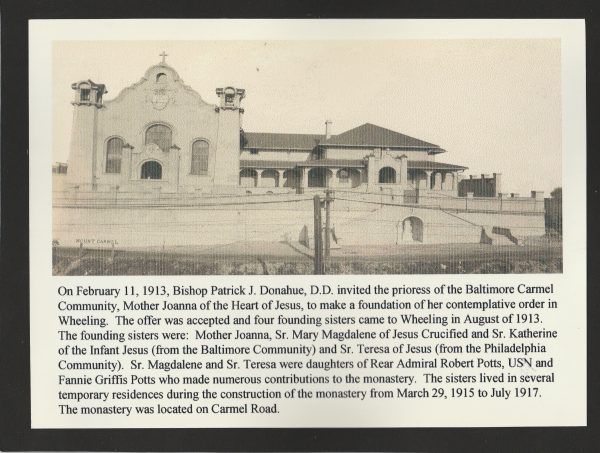
After initially settling in the Fulton area of the Friendly City, the sisters moved to the Goshorn Estate, which was located on the same hillside where the Mount Carmel Monastery would be constructed by Frederick Farris beginning in 1915. Two years later the monastery was complete, and the Carmelite sisters had their home and were secluded for the rest of their respective lives.
Up until the early 1960s the only portion of the Mount Carmel Monastery the public was allowed to visit was the public chapel, but the nuns had their own, and the two areas were the only rooms that were permitted to be beautiful out of respect to The Lord. The Carmelites attended formal prayer sessions beginning daily with 7:30 a.m. Mass, Angelus at noon and again at 6 p.m., and devoted prayer at 4:30 p.m. and at 9:30 p.m.
It was their vocation, one the sisters accepted after living at the monastery for more than a year before taking their vows. They understood the only way they could accept the public’s donation was by turn-wheel that concealed their identify from the rest of the world. Today, there remains only one surviving Carmelite sister who lived and worshiped behind the tall walls of the Mount Carmel Monastery.
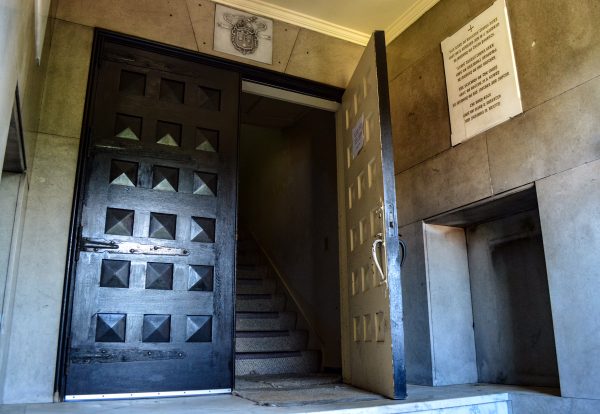
A Cloistered Vocation
Practicing the mortification of the flesh for religious purposes was adopted often inside Catholic monasteries and convents throughout the history of Christianity, and that is why self-flagellation was a practice of penance inside Mount Carmel.
The sisters would whip themselves over the shoulder during private prayer most often using cords that were knotted several times. It was a part of removing themselves from the distractions of society and entering into the cloister to devote themselves to a search for God because they believed their union with The Lord benefited the lives on the other side of those walls.
“The Carmelite sisters were essentially closed off from the rest of the world. They lived behind the grille and in solitude with no exemptions except for being allowed to seek medical attention inside the monastery,” explained Jon-Erik Gilot, the director of archives and records for the Diocese of Wheeling-Charleston. “On one side of the grate there spikes that were sticking out from it, and I believe the spikes were there to keep them from getting too close to the outside world. It was all about solitude and prayer.
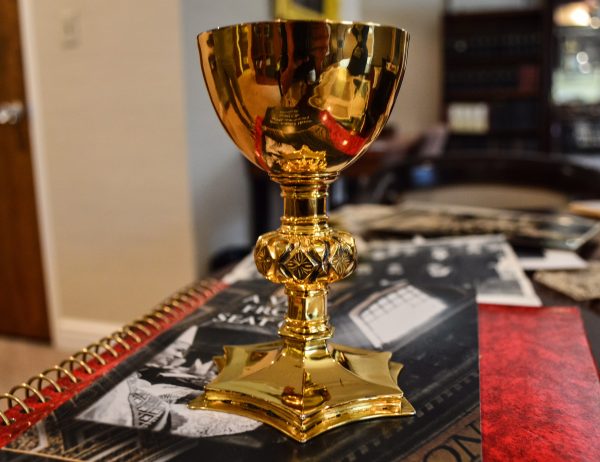
“And for a long time they existed and survived just on food and monetary donations, and if the sisters were hungry, they would ring a bell, and the ladies in the neighborhood would bring them food,” he reported. “They lived by the goodness of the people in the neighborhood, but they did develop a few ways to support themselves, too. They published a newspaper up until 1929, and they would do stitch work, make prayer cards, and postcards to sell. It was all to support a life of prayer.”
St. Michael Church and the school on National Road near Washington Avenue have long rested in the shadow of the monastery, and the student body was taught about the mission of the Carmelite sisters through the 1970s. Those pupils, too, heard the legends of caves and tunnels and other alleged secrets of the order.
While Gilot acknowledged the existence of prayer shelters scattered on the Mount Carmel property that were used by the sisters, he has gathered no records that indicate any underground passageways.
“Because the Carmelite sisters were cloistered, I believe there was some fear and a lot of misinformation that was spread through the community,” he said. “Plus the monastery looks like a daunting place, and they were as strict as it comes, and they lived a Spartan life until Vatican II.
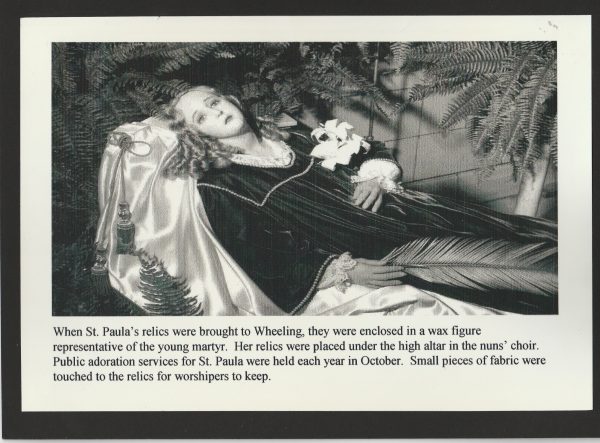
“Plus, once the monastery was constructed, it became the shrine for Saint Paula. Every Catholic church has a relic in it, at least one,” Gilot continued. “At Mount Carmel that had the bones here of Saint Paula, so they had a shrine in her honor. Her head and her hands were there, but those are wax, and her bones were deposited inside. Parishes would make pilgrimages to pray at the shrine for as long as the monastery was still there.”
While the Carmelites were cloistered, the order did come to retain a “tern sister,’ who would handle any public dealings like greeting visitors, retrieving supplies, and answering the monastery’s telephone. She was their one and only link to the outside world.
“And later on they had lay women who would serve as the ‘extern.’ She would go to purchase the supplies and what else they may have needed at that time,” Gilot said. “But no one else was getting behind that steel grille for any reason whatsoever,” he said. “The sisters still had their families, but they weren’t really in contact with them. The sisters became your family. That’s how it worked before Vatican II.”
It was a conducted re-evaluation of the Catholic Faith that took place under a pair of pontiffs (John XXIII and Paul VI) during the early 1960s, and Bishop Hodges represented the Diocese of Wheeling Charleston and sent letters every two weeks for the local newspapers to publish.
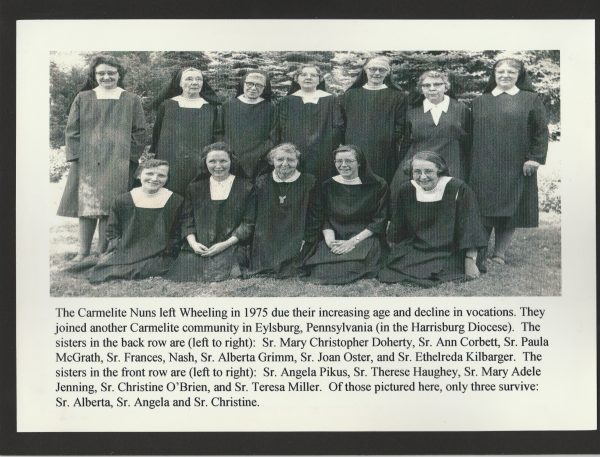
The results of Vatican II altered the practices of Catholicism forever because the rules were relaxed considerably. For example, the Carmelite sisters suddenly could travel beyond those walls.
“From 1962 to 1965 all of the bishops and archbishops were called together to make the Catholic Church closer to what we know today,” Gilot said. “A lot of things changed, like before then the priests used to celebrate Mass with their backs to the people in attendance. Vatican II brought the Catholic religion to a more modern-day religion.
“And it also changed religious communities like Mount Carmel because no more did they have to be cloistered, and the way they dressed was permitted to change, too,” he continued. “For example, the sisters were allowed to start wearing conventional shoes instead of the leather-and-hemp sandals that looked ridiculously uncomfortable. The standards were relaxed, and eventually the Carmelite sisters were allowed to leave the monastery for the first time since arriving.”
Although many believed Vatican II would attract more vocations to the Catholic Church and to the Mount Carmel mission, the numbers continued to decline. The Wheeling Carmelites began searching for a new home in the early 1970s, and the structure was sold to private ownership in 1975.
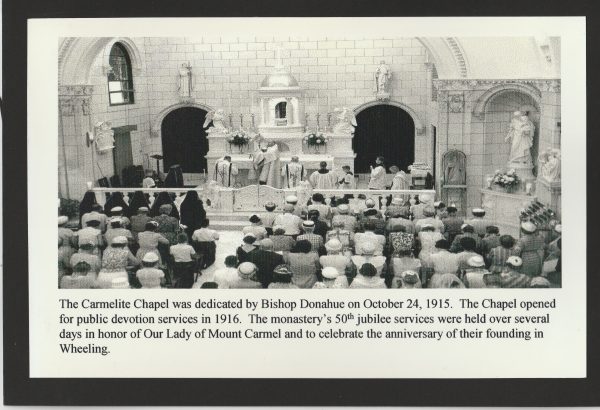
“The sisters made the decision, and it was based on the lack of vocations,” Gilot said. “Sister Angela Pikus was the last vocation there, and I believe she may have entered in 1959 and took her vows a few years after that. So they went for well over a decade with absolutely no new vocations to speak of.
“There are still a lot of people in the Wheeling area who were taught by nuns in parochial school, but today’s children do not experience the same thing,” he said. “What happened with the Carmelites order has really taken place across the board all over the country. Those kinds of religious communities are going away.”
The nuns who passed away while at Mount Carmel were initially interred on the monastery property but have since been moved to the cemetery near the former site of Mount de Chantal Visitation Academy. There is only one Wheeling Carmelite, who lived and prayed in the monastery and whose heart persists to beat, and Gilot has met the lone survivor, Sister Angela Pikus.
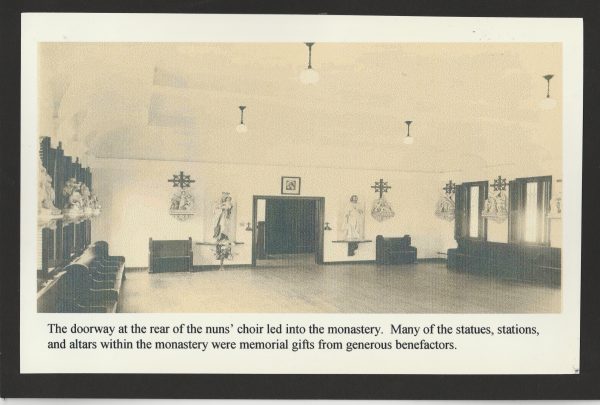
“A few years ago I started receiving letters from her about some of the artifacts that she was still in possession of, and then she told me to come get them because she wasn’t getting any younger,” he explained. “She now lives in a religious community that includes people from all kinds of religious orders, so her life today is much, much different than it was when she was at Mount Carmel.
“But in the 1970s the Carmelite community in Elysburg, Pa., was experiencing the same issues, and they were an old community. What happened was the Wheeling community started writing them and interacting with them, and then they went to stay with them for a while,” Gilot continued. “They ended up living with them for about two years to see if a merger would work.”
And ultimately it did.
“Finally they decided that it would, and I believe it was in 1975 when they officially merged, and then in 1977 Rome granted them what was called an, ‘extinctive union.’ That’s when the Wheeling community ceased to exist, and the Elysburg community ceased to exist,” Gilot added. “That’s when they had the new community that they had put together. Then, in 2008, they joined the Danville community, and now the four or five Carmelites that are still alive reside in that community in Danville, Pa.”
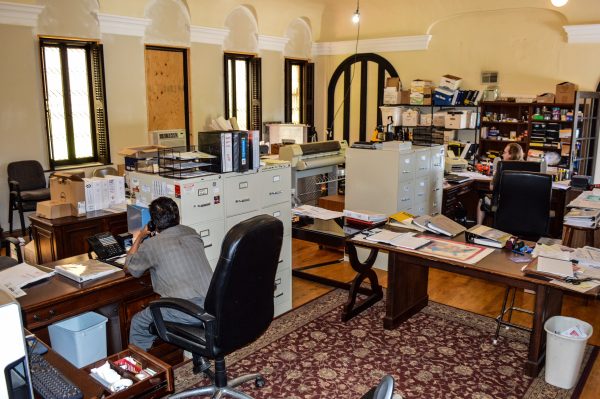
Resurrection for a Sacred Place
The Mount Carmel Monastery has not been the same since being sold to a private owner, and the structure has changed hands more than a few times since the Wheeling Carmelites surrendered the property. An abandoned community coal mine has caused water issues for the landowners, and for periods of time the building has sat empty with tarped sections of roofing. Most often, though, it’s been utilized as an apartment building for college students and working professionals.
But today, the stained-glass windows are gone, and so is the turn-wheel, all removed by owners previous to its current curator, Suki Gupta. And now, Gupta, the owner of the Valley Engineering Co., plans to orchestrate an extensive preservation and renovation project.
He has retained the services of the Property Management Division of Harvey Goodman Realtors, a local company that is one of the leading management firms of historical properties in the city of Wheeling.
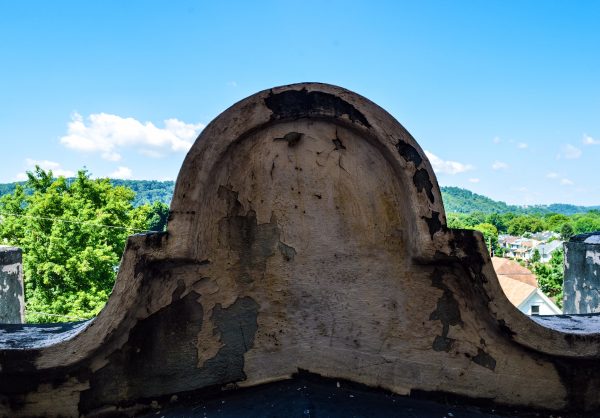
“We basically manage properties that other people own, and we maximize the usefulness and income of those properties,” explained Harvey Goodman’s Emily Shortall. “We were hired by the owner to oversee the renovations of this property, and Susan Hagan is the project coordinator. She will manage the projects that are involved with all of the renovations that will take place here.”
There are now 13 apartments and eight “dorm room” areas in the former monastery, and Hagan already has started the orchestration of Phase I.
“There are three major projects that will take place here at this property, and the first will involve anything we consider the most important because those areas are where the most deterioration has taken place,” Hagan said. “That part will begin with the chimneys, the building’s eyebrows, and the parapets. All of that is expected to begin this week and we have hired Sarel Venter to perform that work.
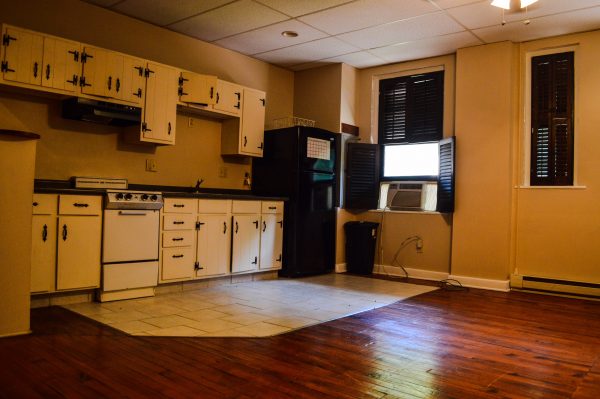
“Then we will move on to the façade of the structure, and from there we will address the retaining walls,” she continued. “We also plan to return the original color and that was white when the monastery first opened in the early 1900s.”
Gupta will receive tax credit for preserving the Mount Carmel Monastery, but more such projects in the Wheeling area, Shortall insisted, could take place in Wheeling’s future. That depends, however, on whether or not West Virginia lawmakers consider and approve altering the possible amount for tax-credit involved investments.
“We are working with several consultants on tax-credit projects including this one,” the property manager said. “There are many buildings around Wheeling that are eligible, and we are working with a group of investors that is very committed to invest in Wheeling. Should we be able to get the tax credits from 10 percent up to 25 percent, we could see a lot of projects take place in this area.
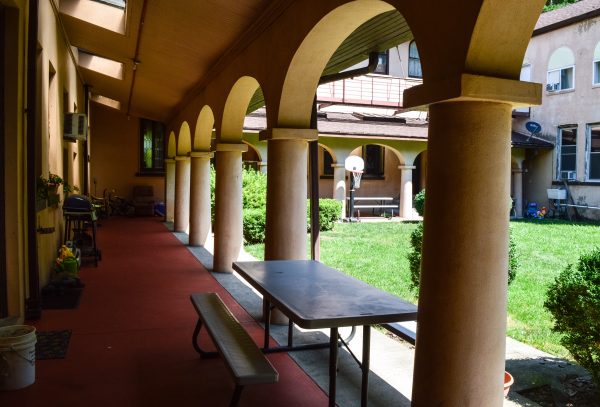
“It’s 25 percent in Ohio, so we are very hopeful that the members of the Legislature will see it as an opportunity for a lot of preservation to take place,” she continued. “That’s our goal, and I’ve been working with the people with Wheeling Heritage, and I believe our next move is to hire a lobbyist to send to Charleston to pitch this idea. There really are several people who are willing to buy properties in Wheeling should the tax credits be what they are in other states.”
Shortall and Hagan have engaged W.Va. Dels. Erikka Storch and Shawn Fluharty, and the firm may take an additional proactive step when the time arrives for the Legislature’s regular session in late January.
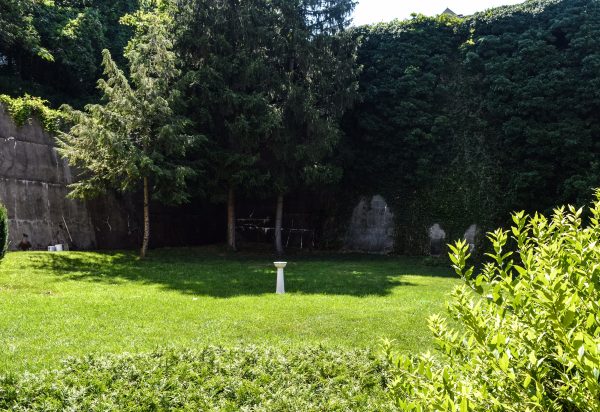
“We already addressed our local lawmakers, but with what has taken place in Charleston recently, this issue has been at a standstill,” Shortall reported. “And with the flooding in a lot of parts of West Virginia, everything really got put on hold, and that’s very understandable. And we’re fine with that because they need to do what needs to be done for those people.
“But I can tell you that the people we’re talking to about investing are looking at six of the largest buildings in Wheeling, so if the increase to the tax credits comes great things will likely happen,” she said. “Right now, though, those buildings are sitting empty so we are hopeful that the lawmakers we have here in Wheeling. There is a chance to attract new companies that will create new jobs and if it takes an increase in the tax credits, why not?”
(Photos by Steve Novotney)


